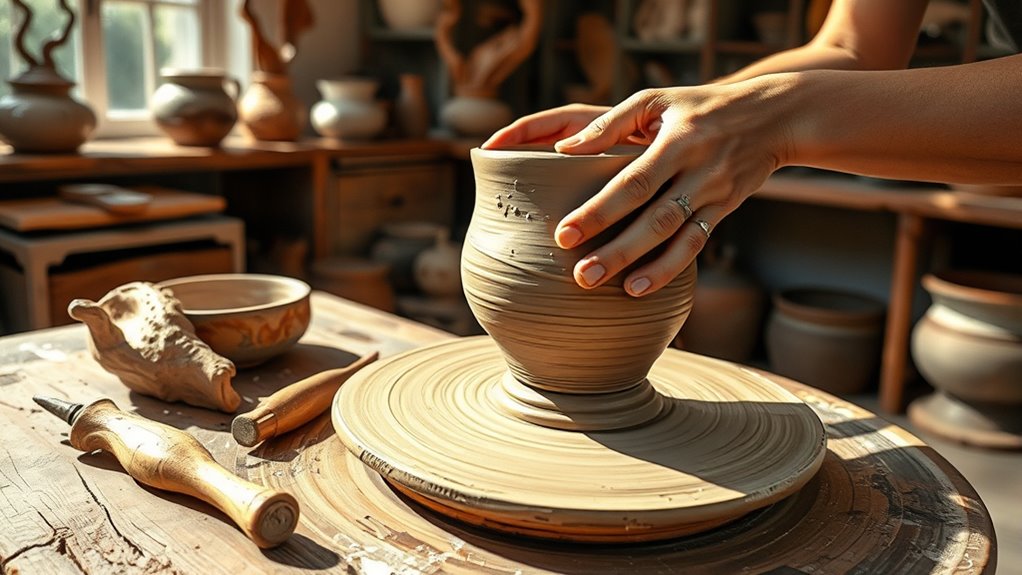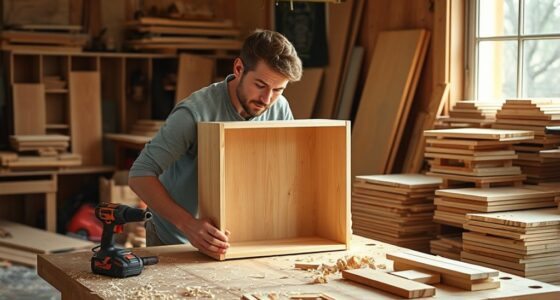Starting pottery at home is easy with simple techniques like hand-building and wheel throwing. First, prepare your clay by wedging thoroughly to remove air bubbles, ensuring it’s uniform and workable. Follow safety tips when firing your kiln, like placing it in a well-ventilated area and cooling it completely before opening. With the right preparation and safety measures, you can create beautiful ceramics comfortably at home—continue to discover tips that make your pottery journey even more rewarding.
Key Takeaways
- Choose the right clay type and thoroughly wedge it to eliminate air bubbles for better workability.
- Practice hand-building techniques like pinching, coiling, and slab construction for versatile projects.
- Use a wheel for wheel-throwing, ensuring your clay is properly prepared and centered for smooth shaping.
- Follow safety procedures, including proper kiln placement, inspection, and cooling, to ensure safe firing at home.
- Post-firing, handle glazed or fired pieces with protective gear and wait for complete cooling before use.

Have you ever thought about creating your own pottery at home? If so, you’re setting out on an exciting journey that combines creativity with craftsmanship. Before you plunge in, it’s essential to understand the basics of clay preparation and kiln safety, which are foundational to producing beautiful, durable pieces and ensuring your safety throughout the process.
Clay preparation is the first step in making pottery. You want to start with the right type of clay—whether it’s earthenware, stoneware, or porcelain—based on your project and firing method. Proper clay preparation involves wedging the clay thoroughly to remove air bubbles and create a uniform consistency. This step is vital because trapped air can cause the clay to explode during firing, damaging your kiln and ruining your work. As you work the clay, knead it with your hands or use a wedging table, applying pressure to eliminate inconsistencies. This process also improves the clay’s workability, making it easier to shape whether you’re hand-building or wheel-throwing. Keep in mind that moist, well-prepared clay will result in smoother surfaces and less cracking. Once the clay is properly wedged, you can begin your shaping process.
When working at home, kiln safety is paramount. If you plan to fire your pottery in a kiln, you must make sure it’s placed in a well-ventilated area, away from flammable materials. Always read and follow the manufacturer’s instructions for your kiln, especially regarding electrical connections and firing schedules. Before firing, double-check that your kiln is in good working order, with no cracks or damage that could cause malfunctions. Remember that kilns can reach extremely high temperatures, so never leave a firing unattended, and always keep a fire extinguisher nearby. After firing, allow the kiln to cool completely before opening it—rushing this process can cause glazed pieces to crack. If you’re using a kiln with a manual or digital controller, familiarize yourself with safety features and emergency shut-off procedures. Proper kiln safety also means wearing protective gear, such as heat-resistant gloves and eye protection, during firing and unloading.
Frequently Asked Questions
What Safety Precautions Should I Take When Working With Clay?
When working with clay, you should always wear a dust mask to protect your lungs from fine particles and guarantee proper ventilation safety in your workspace. Be cautious with clay disposal—dispose of scraps properly to prevent mess and health risks. Keep your area clean, wash your hands thoroughly after handling clay, and avoid inhaling dust. Following these precautions helps keep your pottery experience safe and enjoyable.
How Do I Prevent Cracks and Warping in My Pottery?
Did you know that improper drying causes up to 70% of pottery cracks? To prevent this, monitor your clay moisture levels closely and keep your drying environment consistent. Cover your work with plastic to slow moisture loss, and avoid rapid drying by controlling airflow and temperature. By maintaining steady conditions, you’ll reduce warping and cracks, ensuring your pottery stays beautiful and durable through every stage.
What Are the Best Tools for Beginner Hand-Building Projects?
For your beginner hand-building projects, start with basic tools like wooden modeling tools, a wire cutter, sponge, and a rib tool. These help shape and smooth your pottery effectively. To enhance your glazing techniques and guarantee proper kiln firing, use a kiln with program settings suited for your clay. Practice controlling temperature and atmosphere inside the kiln to avoid cracks and warping, resulting in beautiful, durable pieces.
How Do I Properly Clean and Store Pottery Tools?
You should clean your pottery tools with water and a brush immediately after each use to prevent clay buildup. Dry them thoroughly to avoid rust and store them in a designated container. When glazing, guarantee tools are clean to achieve smooth finishes, and always follow kiln safety guidelines to prevent accidents. Proper cleaning and storage help maintain your tools’ longevity, making your glazing techniques easier and safer.
What Types of Clay Are Best for Home Use?
Ironically, choosing the “best” clay for home use feels like picking a favorite child. You’ll want a versatile clay with good plasticity, like earthenware or stoneware, because their clay composition makes them beginner-friendly. Plus, consider clay color options—white, red, or brown—based on your aesthetic. These clays are easy to work with, forgiving, and perfect for glazing, ensuring your pottery projects turn out beautifully without fuss.
Conclusion
Now that you’ve explored hand-building and wheel throwing, you’re ready to make pottery your own personal canvas. Think of your clay as a blank page waiting to be filled with your creativity, each piece a story you shape with your hands. With patience and practice, you’ll find your rhythm, turning raw material into art that’s uniquely yours. So go ahead—dive in, get your hands dirty, and let your pottery journey blossom like a flower in full bloom.








